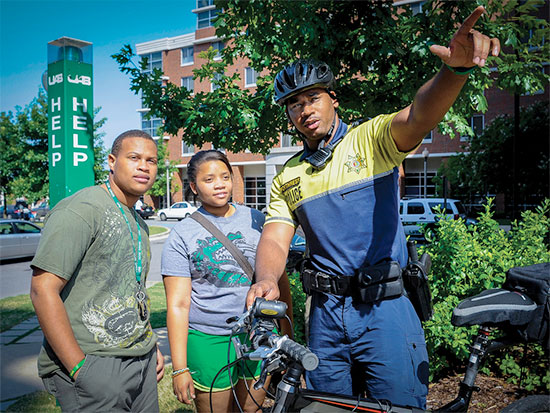 The institution offers many services and resources to promote safety, and continues to add more.A review of Institute of Education Sciences College Navigation data shows the University of Alabama at Birmingham continues to perform as well as or better in safety statistics than similar urban institutions, as well as traditional, non-urban college campuses across the state and beyond.
The institution offers many services and resources to promote safety, and continues to add more.A review of Institute of Education Sciences College Navigation data shows the University of Alabama at Birmingham continues to perform as well as or better in safety statistics than similar urban institutions, as well as traditional, non-urban college campuses across the state and beyond.
UAB comprises 100 city blocks, 23,000-plus employees and nearly 21,000 students. Thousands of patrons of the arts, athletics and other special events visit campus throughout the year, and UAB Hospital logs more than a million patient visits annually.
Despite a vast and complicated footprint, UAB remains among the lowest in incidents of sex-related offences, robbery, aggravated assault and burglary in comparison to urban and non-urban universities in Alabama with more than 16,000 students. UAB also compares favorably to many smaller four-year institutions in Alabama, as well as regional out-of-state peers like Emory University, Florida State University, Middle Tennessee State University, University of Georgia, University of Mississippi, University of Southern Mississippi and Vanderbilt University.
Students seem to notice. In a 2017 survey conducted by Ruffalo Noel Levitz, students reported a satisfaction increase from the previous survey in 2015 to safety-related questions: “The campus is safe and secure for all students,” “Parking lots are well-lighted and secure,” and “Security staff respond quickly in emergencies.”
UAB Police Chief Anthony Purcell, who leads a team of well over 100 accredited officers who provide marked and unmarked, uniformed and non-uniformed patrols across campus, cites theft of personal property as the most common crime on college campuses, including UAB.
“It is important we remind students, faculty and staff that larceny is often a crime of opportunity that can be prevented,” Purcell said. “We encourage people to always lock doors when they leave their residence hall, car or classroom, do not leave valuables visible in vehicles, and do not leave belongings unattended.”
| “As investments in campus surveillance have gained momentum, our officers and detectives have the ability to use that footage to quickly identify, apprehend and charge suspects. If you think you’re likely to get away with something at UAB, don’t.” |
Senior Vice Provost for Enrollment Management Bradley Barnes, whose team is on the front lines of UAB’s record growth in the student body, says the perception of campus safety is finally catching up to the reality. While UAB safety statistics have been comparatively favorable for a decade or more, a 2012 School of Public Health study demonstrated that the perception of crime on campus considerably outweighed actual crime. As awareness has increased, Barnes says the perception of campus safety — once thought to be a deterrent to attending UAB in spite of the data — is becoming a strength.
“The data are important because they help prospective students make decisions based on facts, not outdated misconceptions,” Barnes said. “It is exciting for them when they realize they can benefit from the educational, cultural and career opportunities UAB and Birmingham have to offer without sacrificing safety.”
The institution offers many services and resources to promote safety, and continues to add more.
“Until our campus is completely crime-free, there is work to do, and we will continue our aggressive efforts to work with our constituents and maintain a safe environment,” said UAB President Ray L. Watts. “Our fully accredited police department, in cooperation with campus administrators and officials from areas of operation including Facilities, Emergency Management, Student Life and others — with the support of the University of Alabama System Office and Board of Trustees — are actively investing in a safe campus.”
A recent example is the expanding presence of video cameras on campus. There are now roughly 3,700 video cameras in buildings, parking decks and outdoor areas, and more are on the way.
“Someone who chooses to break the law at UAB should know they are very likely going to be filmed, either in the act, and/or as they approach or leave the scene,” Purcell said. “As investments in campus surveillance have gained momentum, our officers and detectives have the ability to use that footage to quickly identify, apprehend and charge suspects. If you think you’re likely to get away with something at UAB, don’t.”
Purcell says that, while reported crime at UAB is relatively low, continued vigilance is vitally important.
“We need to remember that, whoever and wherever we are, no one is immune to criminal activity, and many crimes can be prevented with planning and awareness,” he said. “Our campus strives to continuously enhance safety through analysis, training and communication, as well as the latest technology.”
Since it was launched in summer 2015, students and employees have been using the free RAVE Guardian safety app, a GPS-enabled panic button and virtual escort that connects directly to UAB Police. Members of the UAB community can also take advantage of on-campus safety escorts, Blazer Express, motorist assistance roadside service, and UAB Police education and safety programs.
Learn more at uab.edu/emergency and uab.edu/police.
